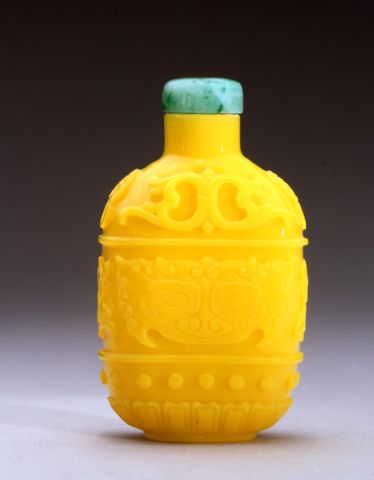
Bottle ID: 00068
YELLOW IMPERIAL, RECTANGULAR, CARVED W/ARCHAIC DESIGNS
Date: 1736-1780
Height: 63 mm
Glass, of flattened rectangular form, of opaque bright yellow tone, carved in relief on each side with a central band of stylized archaic taotie masks, between a band of interlaced archaic scrolls on the shoulders and a band of raised bosses around the foot above a lappet band; the sides carved in the central band with mock mask and ring handles.
Imperial, attributed to the Palace Workshops, Beijing.
Similar Examples:
Lawrence, Clare. Miniature Masterpieces from the Middle Kingdom - The Monimar Collection of Chinese Snuff Bottles, 1996, pp. 236-237, no. 112.135.
Moss, Hugh, Victor Graham and Ka Bo Tsang. A Treasury of Chinese Snuff Bottles - The Mary and George Bloch Collection, 1995, Vol. 1, pp. 384-385, no. 148.
Sotheby's, New York, September 17, 1996, lot 18, Collection of Bernice Straus Hasterlik.
Provenance:
Clare Lawrence Ltd.
Sotheby's, London, April 24, 1989, lot 181
Kenneth Atkinson, Australia
Exhibited:
Annual Convention ICSBS Toronto, October 2007
Published:
JICSBS, Autumn 2006, Front Cover
JICSBS, Autumn 1989, p. 27, fig. 5
The use of stylized taotie masks as a central design is taken directly from archaic bronzes of the Shang Dynasty. Taotie mask designs are often depicted on bronze tripod censers as the main motif. It is likely that the designs ordered by the Zaobanchu to the glass workshops were copied from bronze objects from previous periods that were placed around the Forbidden City. On this eighteenth century opaque yellow glass bottle, the design is used in precisely the same way although the surface on the main fascias are flat rather than curved as they would be on bronze vessels. The Qianlong Emperor, like his predecessors, had a preference for archaism as a style to be depicted on both works of art and snuff bottles. Often this is seen on jade vases and on jade snuff bottles such as the example cited above from the Bloch Collection which has taotie masks carved on a nephrite bottle. More rarely it occurs as a central theme on glass bottles, although most examples are accompanied as this one is by a Palace attribution and an eighteenth century date. The Qing Emperors were Manchu usurpers of the Han Court. Despite their nomadic warrior-like ancestry, the Emperors, particularly from Kangxi onwards, saw the value in the Han culture and attempted with much success, to emulate it. Rather than imposing their own culture on the indigenous people, they embraced the existing culture, thus perpetuating a climate where art had value. This extended to the Zaobanchu and the Palace Workshops, where the additional influence of the European Jesuits present at Court was also evident.
< Back to full list
 English
English 中文
中文